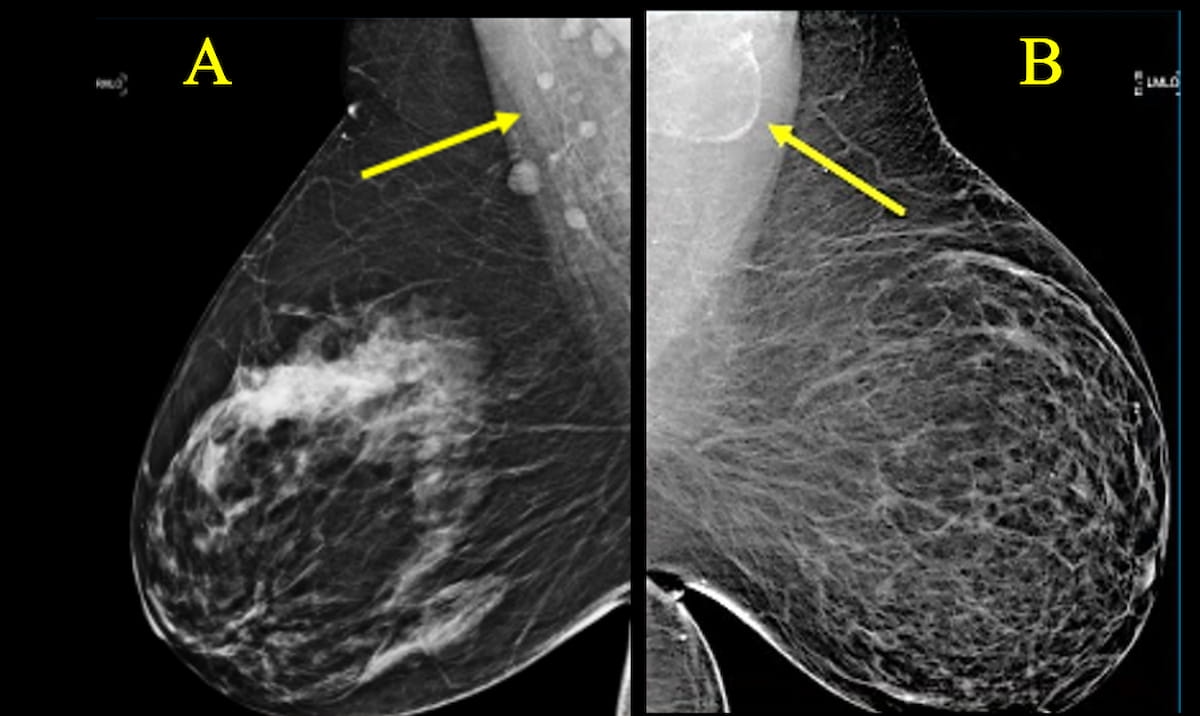- AI
- Molecular Imaging
- CT
- X-Ray
- Ultrasound
- MRI
- Facility Management
- Mammography
Mammography Study Shows Link Between Enlarged Axillary Lymph Nodes and Higher Risks for Diabetes and Cardiovascular Disease
The presence of fat-enlarged axillary lymph nodes on mammography screening exams is associated with a fourfold higher risk of type 2 diabetes and a 2.6-fold higher risk for cardiovascular disease, according to new research presented at the ARRS Annual Meeting.
Emerging research suggests the detection of fat-enlarged axillary lymph nodes on screening mammography exams may be associated with significantly higher risks of type 2 diabetes (T2DM), cardiovascular disease (CVD), and hypertension (HTN).
In a retrospective study, which garnered Summa Cum Laude honors at the 2024 American Roentgen Ray Society (ARRS) Annual Meeting in Boston, researchers reviewed bilateral mediolateral oblique views from mammography exams for 1,216 women who had cardiovascular risk factors within one year of the mammogram but no known coronary artery disease (CAD) at the time of the mammography screening. The study authors measured the largest visible axillary lymph node and also determined if the patients had any major adverse cardiovascular events (MACEs) within 10 years after the index mammogram.
The researchers found that 19.1 percent of the cohort had fat-enlarged axillary lymph nodes (greater than 20 mm in length) due to an expanded fatty hilium. For these patients, the study authors noted a fourfold higher risk for T2DM, a 2.6-fold higher risk of CVD, and a 2.5-fold higher risk of HTN.
Here one can see a comparison between mammography findings for two women with similar body mass index (BMI). Note the normal axillary lymph nodes in a 63-year-old woman (A) and a fat-enlarged axillary lymph node in a 52-year-old woman (B). New research revealed a fourfold higher risk of type 2 diabetes and a 2.6-fold higher risk for cardiovascular disease in women presenting with fat-enlarged axillary lymph nodes on mammography exams. (Images courtesy of the American Roentgen Ray Society (ARRS).

“Fat-enlarged axillary lymph nodes visualized on screening mammography may increase the ability to identify women who would benefit from CVD risk reduction strategies and more intensive risk assessment with coronary artery CT,” suggested lead study author Jessica Rubino, M.D., who is affiliated with the Dartmouth Hitchcock Medical Center in Lebanon, N.H., and colleagues.
The researchers noted that axillary lymph nodes were visible on 907 of the 1216 mammography exams reviewed in the study (74.6 percent). Emphasizing the wide eligibility for screening mammography for over 75 percent of women in the United States, the study authors emphasized that obtaining cardiovascular risk data from mammograms could have a significant impact in reducing mortality from CVD, the leading cause of death in women.
“If validated in larger studies, incorporating fat-enlarged nodes into CVD risk models has the potential to improve CVD risk stratification without additional cost or additional testing,” posited Rubino and colleagues.
Reference
1. Rubino J, Austin-Strohbehn J, Wang Q, et al. Fat-enlarged axillary lymph nodes on screening mammograms predict cardiometabolic disease and cardiovascular disease risk. Presented at the 2024 American Roentgen Ray Society (ARRS) Annual Meeting in Boston, May 5-9, Boston. Available at: https://apps.arrs.org/MeetingPortal24/ . Accessed May 5, 2024.
Can AI Bolster Breast Cancer Detection in DBT Screening?
January 16th 2025In sequential breast cancer screening with digital breast tomosynthesis (DBT), true positive examinations had more than double the AI case score of true negative examinations and the highest positive AI score changes from previous exams, according to new research.
Mammography Study Suggests DBT-Based AI May Help Reduce Disparities with Breast Cancer Screening
December 13th 2024New research suggests that AI-powered assessment of digital breast tomosynthesis (DBT) for short-term breast cancer risk may help address racial disparities with detection and shortcomings of traditional mammography in women with dense breasts.
